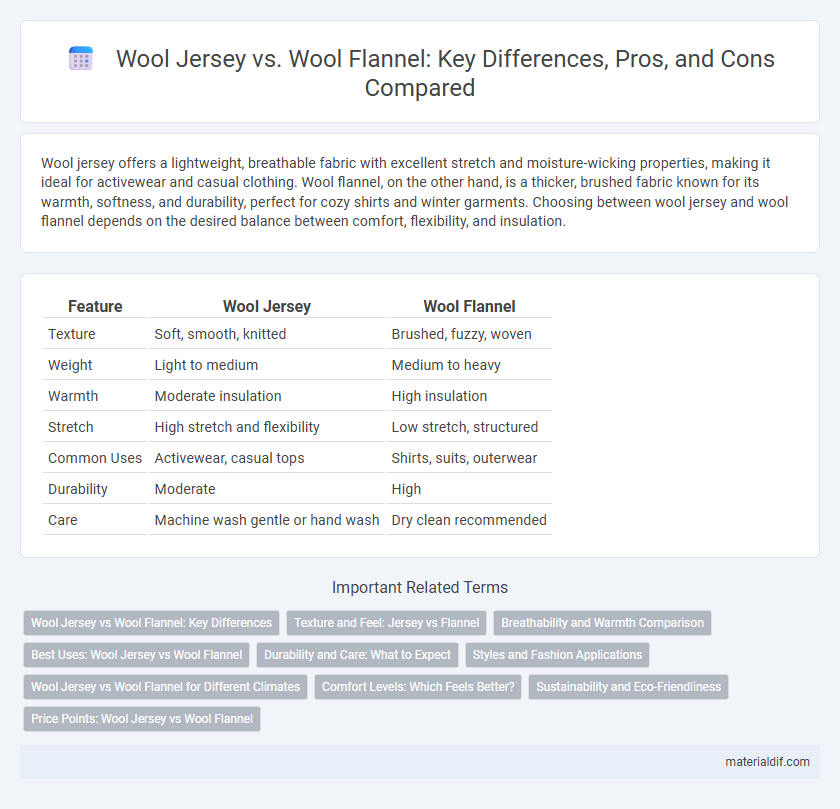Wool jersey offers a lightweight, breathable fabric with excellent stretch and moisture-wicking properties, making it ideal for activewear and casual clothing. Wool flannel, on the other hand, is a thicker, brushed fabric known for its warmth, softness, and durability, perfect for cozy shirts and winter garments. Choosing between wool jersey and wool flannel depends on the desired balance between comfort, flexibility, and insulation.
Table of Comparison
| Feature | Wool Jersey | Wool Flannel |
|---|---|---|
| Texture | Soft, smooth, knitted | Brushed, fuzzy, woven |
| Weight | Light to medium | Medium to heavy |
| Warmth | Moderate insulation | High insulation |
| Stretch | High stretch and flexibility | Low stretch, structured |
| Common Uses | Activewear, casual tops | Shirts, suits, outerwear |
| Durability | Moderate | High |
| Care | Machine wash gentle or hand wash | Dry clean recommended |
Wool Jersey vs Wool Flannel: Key Differences
Wool jersey features a stretchy, knit texture ideal for lightweight, breathable garments, while wool flannel offers a soft, brushed finish with a denser weave that provides superior warmth and insulation. Wool jersey typically suits activewear and casual clothing due to its flexibility, whereas wool flannel is preferred for tailored suits, trousers, and winter outerwear because of its durability and classic appearance. The choice between wool jersey and wool flannel hinges on desired warmth, texture, and garment function.
Texture and Feel: Jersey vs Flannel
Wool jersey features a smooth, stretchy texture with a soft, lightweight feel ideal for comfortable, breathable garments. Wool flannel offers a dense, brushed surface that feels warm, cozy, and slightly fuzzy, providing excellent insulation. Jersey's knit construction delivers flexibility and drape, while flannel's woven fabric emphasizes durability and a classic, textured finish.
Breathability and Warmth Comparison
Wool jersey offers superior breathability due to its lightweight, open-knit structure, allowing for better moisture-wicking and airflow during active wear. Wool flannel provides enhanced warmth with its densely woven, brushed fibers that trap heat effectively, making it ideal for colder climates. Choosing between wool jersey and wool flannel depends on the balance needed between thermal insulation and ventilation for specific weather conditions.
Best Uses: Wool Jersey vs Wool Flannel
Wool jersey, known for its lightweight stretch and breathability, excels in activewear and layering pieces where flexibility and moisture-wicking are essential. Wool flannel offers a warmer, thicker texture with a soft brushed finish, making it ideal for tailored suits, winter shirts, and cozy outerwear that require insulation and durability. Choosing between wool jersey and wool flannel depends on the intended use, with jersey suited for comfort and movement, while flannel suits cold-weather protection and formal styles.
Durability and Care: What to Expect
Wool jersey features a smooth, lightweight knit that offers moderate durability and requires gentle washing methods such as hand washing or dry cleaning to maintain fabric integrity. Wool flannel is a denser, woven fabric known for superior durability and resilience, often tolerating more frequent cleaning with careful machine washing on delicate cycles or dry cleaning. Both fabrics benefit from air drying and avoiding high heat to prevent shrinkage and preserve softness over time.
Styles and Fashion Applications
Wool Jersey offers a sleek, stretchy texture ideal for form-fitting garments like tailored dresses and casual sweaters, enhancing both comfort and modern style. Wool Flannel features a soft, brushed surface creating a warm, matte finish perfect for classic blazers, trousers, and winter coats with a timeless, sophisticated appeal. Fashion applications of Wool Jersey lean towards activewear and contemporary casual wear, while Wool Flannel is favored in traditional suiting and formal outerwear for its refined look and durability.
Wool Jersey vs Wool Flannel for Different Climates
Wool jersey offers lightweight breathability and moisture-wicking properties, ideal for mild to warm climates where comfort and flexibility are essential. Wool flannel provides thicker insulation and superior warmth, making it suitable for colder environments that require enhanced heat retention and durability. Choosing between wool jersey and wool flannel depends on the specific climate demands, balancing temperature regulation and comfort.
Comfort Levels: Which Feels Better?
Wool jersey offers a lightweight, stretchy texture that provides a smooth, breathable comfort ideal for active wear and layering. Wool flannel features a thicker, brushed surface delivering warmth and softness, perfect for cooler climates and cozy garments. Preferences for comfort often depend on climate and usage, with jersey favored for flexibility and flannel prized for insulation.
Sustainability and Eco-Friendliness
Wool jersey offers a sustainable advantage due to its lightweight, breathable knit structure, which requires less energy to produce compared to the denser weave of wool flannel. Wool flannel, while durable and insulating, often involves more intensive processing and higher resource consumption, impacting its eco-friendliness. Both fabrics benefit from wool's natural biodegradability and renewable sourcing, but wool jersey's production efficiency makes it a more eco-friendly choice in sustainable textile practices.
Price Points: Wool Jersey vs Wool Flannel
Wool jersey typically costs less than wool flannel due to its simpler knit construction and lower production complexity, making it a budget-friendly option for lightweight and stretchy garments. Wool flannel, known for its dense weave and brushed finish, commands a higher price point as it requires more intricate manufacturing processes and offers superior warmth and texture. Consumers often choose wool flannel for premium cold-weather apparel, while wool jersey appeals to those seeking affordable, comfortable layering pieces.
Wool Jersey vs Wool Flannel Infographic

 materialdif.com
materialdif.com